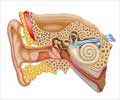- Ears and Altitude - (http://www.entnet.org/content/ears-and-altitude)
- Ear - blocked at high altitudes - (https://www.nlm.nih.gov/medlineplus/ency/article/002077.htm)
- Anatomy and Physiology of the Ear - (http://www.stanfordchildrens.org/en/topic/default?id=anatomy-and-physiology-of-the-ear-90-p02025)
- Stephen Chad Kanick, William J. Doyle. Barotrauma during air travel: predictions of a mathematical model. Journal of Applied Physiology 2005 Vol. 98 no. 5, 1592-1602.
- How Our Balance System Works - (http://www.asha.org/public/hearing/how-our-balance-system-works/)
- Ears and Airplane Travel, Ear Wax, and Ear Cleaning - (http://www.hopkinsmedicine.org/healthlibrary/conditions/otolaryngology/ears_and_airplane_travel_ear_wax_and_ear_cleaning_85,p00473/)
- Barotrauma during air travel: predictions of a mathematical model - (http://jap.physiology.org/content/98/5/1592.long)
- Flying's Effects on Ears - (http://kidshealth.org/en/parents/flying-ears.html#)
What is Airplane Ear?
Airplane ear is a ear condition that occurs in situations associated with sudden changes in environmental air pressure. Under normal conditions, the air pressure maintained inside the middle ear is the same as that of the environment.
During takeoff on a flight or while landing, there is a sudden change in external air pressure that creates a pressure difference between the middle ear and the outside, resulting in airplane ear. Airplane ear is also called ear barotrauma, ear popping, barotitis media, pressure related ear pain or eustachian tube dysfunction.
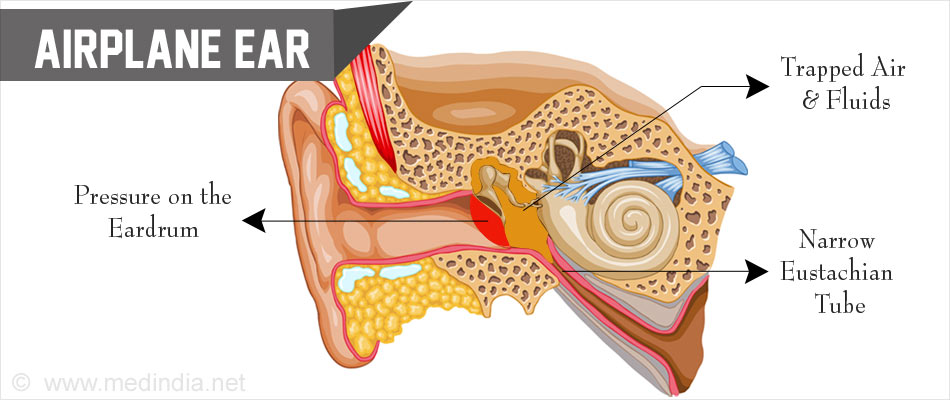
Anatomy of the Ear
The ear consists of three parts external, middle and inner ear-
Outer Ear: The outer part of the ear is called the pinna or the auricle. The outer ear is connected to the middle ear through an external auditory tube or canal. It is separated from the middle ear by a membrane called the eardrum.
Middle Ear: The middle ear contains three bones that are essential for hearing. The bones are connected to each other and are:
- Malleus
- Incus
- Stapes
The malleus is attached to the eardrum while the stapes is attached to the top part of the inner ear. The incus connects the malleus and stapes.
A tube called the Eustachian tube connects the back of the nose to the middle ear. This helps to maintain equal air pressure on either side of the eardrum.
Inner Ear: The inner ear contains specific compartmentalized areas that are specialized for the purpose of hearing and maintenance of balance.
Transmission of Hearing
When a sound wave enters the ear it vibrates the eardrum. This leads to the three hearing bones transmitting the sound waves to the special fluid present in the inner ear. This results in the initiation of a nerve impulse that travels to the brain via the auditory nerve, the nerve responsible for hearing.
Balance:
The inner ear plays an important role in balance. There are three semi-circular canals in the inner ear that aid in balance. These canals are filled with fluid and lined with specialized cells. When there is a movement of the head, the sensors send nerve impulses to the brain, letting the brain know if there is movement or where in space the individual is.
What are the Causes of Airplane Ear?
Airplane ear is associated with conditions and situations that lead to a difference in air pressure on either side of the eardrum. These include:
- Scuba diving
- Parasailing
- Mountaineering or driving in the mountains
- Allergies
- Upper respiratory tract infection
- Infection in the ear
- Blocked eustachian tube
- Flight take off and landing
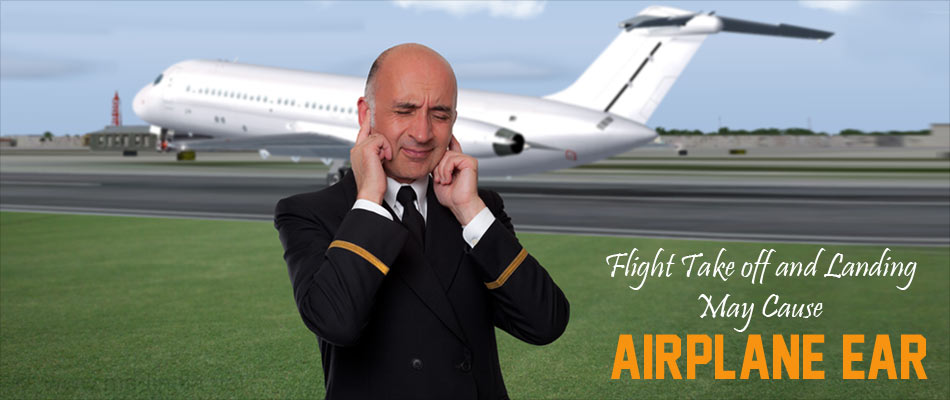
What Happens During Airplane Ear?
Stephen Chad Kanick and William J Doyle detailed what happens in an airplane ear in their article titled “Barotrauma during air travel: Predictions of a mathematical model” and published in the Journal of Applied Physiology.
Changes in cabin pressure during take-off and landing lay additional stress on the middle ear pressure regulating the system and lead to barotrauma. Individuals with good Eustachian tube opening regulate the change in pressure better than those with a compromised Eustachian tube opening. Children, infants and people suffering from repeated cold do not have a good Eustachian tube pressure regulating mechanism.
When the gas flow across the Eustachian tube does not lead to a leveling of pressure quickly, it can lead to a pressure difference between the middle ear and the outside. This could result in changes in the ear like:
- Air pocket formation within the middle ear
- Tearing of the eardrum
- Focal bleeds
- Fluid accumulation in the middle ear
What are the Symptoms of Airplane Ear?
The symptoms of airplane ear are:
- Discomfort or a feeling of fullness in one or both the ears, or pain in more severe cases
- Mild hearing loss
- A feeling of stuffiness in the ears
- Nose bleeding in severe cases.
- Dizziness
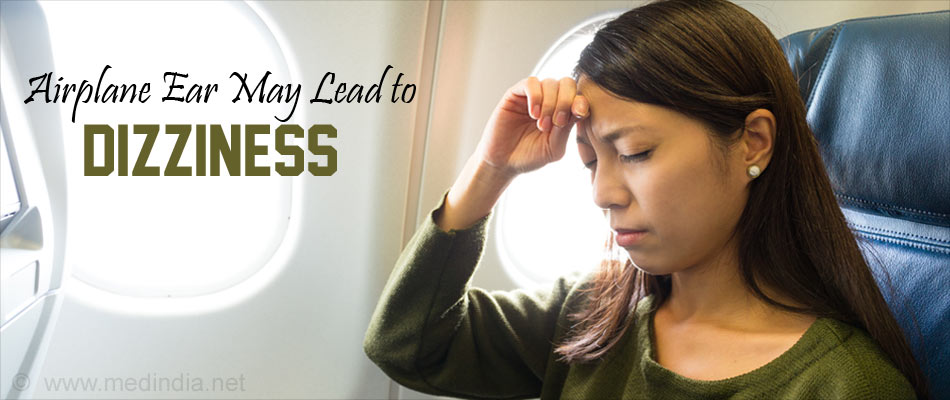
How do you Diagnose Airplane Ear?
Airplane ear is usually diagnosed based on the history and symptoms obtained from the patient.
Otoscope: This is an instrument with light that is used to examine the ear. The signs that are generally looked out for using an otoscope are:
- A small bulge of the eardrum, either inward or outward.
- Tear in the eardrum
- Presence of blood or fluid on the other side of the eardrum
Audiometry: This is a test performed to estimate the individual’s ability to hear. Audiometry test is recommended when there is loss of hearing.
How do you Treat Airplane Ear?
Airplane ear can usually be managed with simple techniques. Yawning or swallowing helps to open the Eustachian tube, reducing the pressure difference and the symptoms associated with it.
Valsalva Maneuver:
In this maneuver, the nostrils of the nose need to be closed by pinching them together with your fingers. The mouth should also be firmly closed. Now, air should be forced into the nose, which will then open the Eustachian tube.
In rare cases, the symptoms may persist despite the above methods and the patient may require further treatment.

Medications:
Airplane ear that is caused due to prolonged cold or due to allergies will have to be treated with medications to control cold as well as allergies.
Surgery:
Surgery is very rarely necessary. However, a myringotomy is performed, in severe cases, on the ear drum to ease the pressure as well as to remove the accumulated fluids. Myringotomy is a surgical procedure of the eardrum.
Prevention of Airplane Ear
Here are some ways to prevent airplane ear:
- Do not travel by air if you have had a cold for a prolonged period of time.
- Adults can carry a decongestant to remove nose blocks.
- Yawning and swallowing have been shown to reverse airplane ear
- Drink plenty of water as it will avoid dehydration which can irritate the sinus and increase symptoms
- Do the Valsalva maneuver to prevent airplane ear.
- Chew gum or put a hard candy in your mouth, which will force you to keep swallowing excess saliva
- Use ear plugs
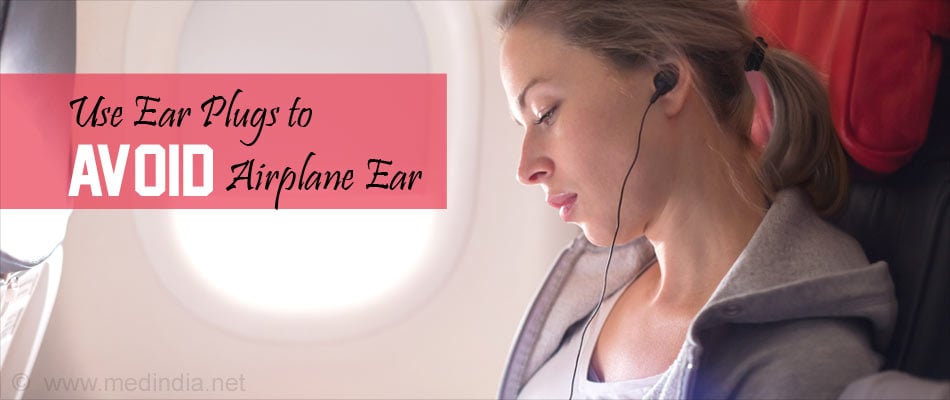
Health Tips to Avoid Airplane Ear
- Drink plenty of water: Drinking water will help you stay hydrated and will also encourage swallowing, thereby removing airplane ear.
- Treat ear infections: Treat ear infections, especially in children, before opting to fly.
- Do not sleep during takeoff and landing: In order to overcome airplane ear, it is important to stay awake and to carry out self help measures like the Valsalva maneuver and yawning.
- Breastfeed infants: Infants are too small to be able to yawn or to swallow on their own. Breastfeeding them will help solve the problem as it will pop their ears as they swallow the milk



